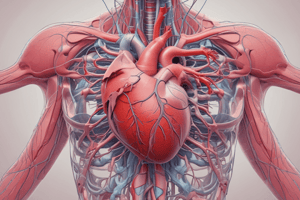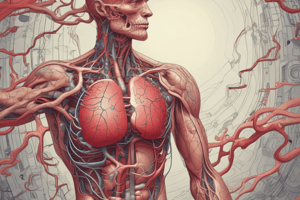Podcast
Questions and Answers
Blood flows through a network of blood vessels that extend from the _________________ to the peripheral tissues.
Blood flows through a network of blood vessels that extend from the _________________ to the peripheral tissues.
heart
Blood is carried away from the heart by:
Blood is carried away from the heart by:
- Arteries (correct)
- Veins
- Venules
- Capillaries
Capillaries are often called ___________________ as their thin walls permit exchange of nutrients, dissolved gases and waste products between the blood and surrounding tissues.
Capillaries are often called ___________________ as their thin walls permit exchange of nutrients, dissolved gases and waste products between the blood and surrounding tissues.
exchange vessels
How many muscular chambers does the heart contain?
How many muscular chambers does the heart contain?
The right atrium passes blood to the right ventricle, which pumps blood into the:
The right atrium passes blood to the right ventricle, which pumps blood into the:
The left atrium empties blood into the left ventricle, which pumps blood into the:
The left atrium empties blood into the left ventricle, which pumps blood into the:
When the heart beats, the ventricles contract at the same time and the right ventricle ejects a _________ amount of blood than the left ventricle.
When the heart beats, the ventricles contract at the same time and the right ventricle ejects a _________ amount of blood than the left ventricle.
The heart has a series of _____________ valves.
The heart has a series of _____________ valves.
The right atrioventricular (AV) valve is known as the:
The right atrioventricular (AV) valve is known as the:
Semilunar valves include:
Semilunar valves include:
Blood from the systemic circuit flows through the venae cavae into the:
Blood from the systemic circuit flows through the venae cavae into the:
Which type of cells control and coordinate heartbeat?
Which type of cells control and coordinate heartbeat?
Each heartbeat begins with an action potential generated at a pacemaker called the:
Each heartbeat begins with an action potential generated at a pacemaker called the:
Electrical events of the conducting system can be monitored from the surface of the body by means of an:
Electrical events of the conducting system can be monitored from the surface of the body by means of an:
The arrival of an electrical impulse at a cardiac muscle cell membrane produces an _________ (comparable to that in a skeletal muscle fibre), and this triggers the contraction of the cardiac muscle cell.
The arrival of an electrical impulse at a cardiac muscle cell membrane produces an _________ (comparable to that in a skeletal muscle fibre), and this triggers the contraction of the cardiac muscle cell.
The period between the start of one heartbeat and the start of the next is called the:
The period between the start of one heartbeat and the start of the next is called the:
In contrast to skeletal muscle, cardiac muscle tissue contracts:
In contrast to skeletal muscle, cardiac muscle tissue contracts:
The cardiac conduction system contains each the following elements, EXCEPT:
The cardiac conduction system contains each the following elements, EXCEPT:
The conducting cells in the atria are found in:
The conducting cells in the atria are found in:
Each time the heart beats, a wave of depolarization travels down the ventricular septum to the apex of the heart, from where it spreads through the ventricular:
Each time the heart beats, a wave of depolarization travels down the ventricular septum to the apex of the heart, from where it spreads through the ventricular:
The electrical activity of the heart can be monitored by means of a graphical recording, which gives information on performance of each of the following specific components, EXCEPT:
The electrical activity of the heart can be monitored by means of a graphical recording, which gives information on performance of each of the following specific components, EXCEPT:
Which appears as the ventricles depolarize?
Which appears as the ventricles depolarize?
The P-R interval is the time from the start of ________________ to the start of the QRS complex and extension by even 0.2 sec can indicate damage to the conducting pathways or the atrioventricular (AV) node.
The P-R interval is the time from the start of ________________ to the start of the QRS complex and extension by even 0.2 sec can indicate damage to the conducting pathways or the atrioventricular (AV) node.
The Q-T interval indicates the time required for the ventricles to undergo a single cycle of depolarization and repolarization and extension may indicate all of the following, EXCEPT:
The Q-T interval indicates the time required for the ventricles to undergo a single cycle of depolarization and repolarization and extension may indicate all of the following, EXCEPT:
The action potential in a contractile cell is different than that observed in a skeletal muscle cell in that it has each of the following distinct steps, EXCEPT:
The action potential in a contractile cell is different than that observed in a skeletal muscle cell in that it has each of the following distinct steps, EXCEPT:
An action potential begins when the membrane of a ventricular muscle cell reaches threshold (-75 mV) from the resting potential of -90 mV, this results in opening of:
An action potential begins when the membrane of a ventricular muscle cell reaches threshold (-75 mV) from the resting potential of -90 mV, this results in opening of:
The plateau phase of a cardiac action potential lasts for:
The plateau phase of a cardiac action potential lasts for:
At the end of the plateau phase potassium (K+) channels open leading to a rapid repolarization that restores:
At the end of the plateau phase potassium (K+) channels open leading to a rapid repolarization that restores:
In the cardiac cycle, a phase of contraction is known as:
In the cardiac cycle, a phase of contraction is known as:
Systole is followed by ____________ during which the chamber fills with blood.
Systole is followed by ____________ during which the chamber fills with blood.
There are _________ heart sounds.
There are _________ heart sounds.
Cardiodynamics is NOT dictated by which of the following factors:
Cardiodynamics is NOT dictated by which of the following factors:
Cardiac output is an indication of blood flow through peripheral tissues and provides a useful indication of:
Cardiac output is an indication of blood flow through peripheral tissues and provides a useful indication of:
An increased heart rate is primarily caused by which one of the following:
An increased heart rate is primarily caused by which one of the following:
An increased stroke volume is primarily caused by:
An increased stroke volume is primarily caused by:
____________________ is calculated as the end-diastolic volume (EDV, ~135 ml) minus the end-systolic volume (ESV, ~65 ml).
____________________ is calculated as the end-diastolic volume (EDV, ~135 ml) minus the end-systolic volume (ESV, ~65 ml).
The end systolic volume (ESV) is influenced by each of the following, EXCEPT:
The end systolic volume (ESV) is influenced by each of the following, EXCEPT:
Pressure within the cardiovascular system, the circulatory pressure is often divided into each of the following components EXCEPT:
Pressure within the cardiovascular system, the circulatory pressure is often divided into each of the following components EXCEPT:
For circulation to occur the pressure gradient must be great enough to overcome the:
For circulation to occur the pressure gradient must be great enough to overcome the:
Blood flow is determined by each of the following parameters, EXCEPT:
Blood flow is determined by each of the following parameters, EXCEPT:
Flashcards are hidden until you start studying
Study Notes
The Cardiovascular System
- Blood flows through a network of blood vessels from the heart to the peripheral tissues.
- Arteries carry blood away from the heart.
- Capillaries are thin-walled vessels that allow for the exchange of nutrients, gases, and waste products between the blood and surrounding tissues.
- The heart contains four muscular chambers.
- The right atrium passes blood to the right ventricle, which pumps blood into the pulmonary circuit.
- The left atrium empties blood into the left ventricle, which pumps blood into the systemic circuit.
- The right ventricle ejects a smaller amount of blood than the left ventricle during each heartbeat.
- The heart has a series of one-way valves.
- The right atrioventricular (AV) valve is called the tricuspid valve.
- Semilunar valves include the aortic valves.
- Blood from the systemic circuit flows through the vena cavae into the right atrium.
- Cells of the conducting system control and coordinate the heartbeat.
- Each heartbeat begins with an action potential generated at the sinoatrial (SA) node, also known as the pacemaker.
- Electrical events of the conducting system can be monitored from the surface of the body by means of an electrocardiogram (ECG).
- The arrival of an electrical impulse at a cardiac muscle cell membrane produces an action potential, triggering the contraction of the cardiac muscle cell.
- The period between the start of one heartbeat and the start of the next is called the cardiac cycle.
- In contrast to skeletal muscle, cardiac muscle tissue contracts on its own.
- The conducting cells in the atria are found in internodal pathways.
- Each time the heart beats, a wave of depolarization travels down the ventricular septum to the apex of the heart, from where it spreads through the ventricular myocardium.
- The electrical activity of the heart can be monitored by means of an ECG.
- The QRS complex appears as the ventricles depolarize.
- The P-R interval is the time from the start of atrial depolarization to the start of the QRS complex.
- The Q-T interval indicates the time required for the ventricles to undergo a single cycle of depolarization and repolarization.
- The action potential in a contractile cell is different than that observed in a skeletal muscle cell in that it has a plateau phase.
- An action potential begins when the membrane of a ventricular muscle cell reaches threshold, resulting in the opening of fast sodium (Na+) channels.
- The plateau phase of a cardiac action potential lasts for ~175 msec.
- At the end of the plateau phase, potassium (K+) channels open leading to a rapid repolarization.
- A phase of contraction in the cardiac cycle is known as systole.
- Diastole follows systole, during which the chamber fills with blood.
- There are two heart sounds.
- Cardiac output (CO) is NOT dictated by the glomerular filtration rate (GFR).
- Cardiac output is an indication of blood flow through peripheral tissues and provides a useful indication of ventricular efficiency.
- An increased heart rate is primarily caused by increased activity of sympathetic nerves to the heart.
- An increased stroke volume is primarily caused by increased end-diastolic ventricular volume.
- Stroke volume is calculated as the end-diastolic volume (EDV) minus the end-systolic volume (ESV).
- The end systolic volume (ESV) is influenced by preload, afterload, and contractility.
- For circulation to occur, the pressure gradient must be great enough to overcome the total peripheral resistance.
- Blood flow is determined by the vessel radius, total peripheral resistance, blood pressure, and vessel length.
Studying That Suits You
Use AI to generate personalized quizzes and flashcards to suit your learning preferences.




